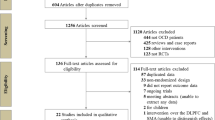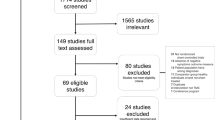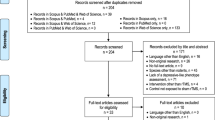Abstract
Clinical trials on low-frequency repetitive transcranial magnetic stimulation (LF-rTMS) over the right dorsolateral prefrontal cortex have yielded conflicting evidence concerning its overall efficacy for treating major depression (MD). As this may have been the result of limited statistical power of individual trials, we have carried the present systematic review and meta-analysis to examine this issue. We searched the literature for English language randomized, double-blind and sham-controlled trials (RCTs) on LF-rTMS for treating MD from 1995 through July 2012 using EMBASE, PsycINFO, Cochrane Central Register of Controlled Trials, SCOPUS, and ProQuest Dissertations & Theses, and from October 2008 until July 2012 using MEDLINE. The main outcome measures were response and remission rates as well as overall dropout rates at study end. We used a random-effects model, odds ratios (ORs) and number needed to treat (NNT). Data were obtained from eight RCTs, totaling 263 subjects with MD. After an average of 12.6±3.9 rTMS sessions, 38.2% (50/131) and 15.1% (20/132) of subjects receiving active LF-rTMS and sham rTMS were classified as responders (OR=3.35; 95% CI=1.4–8.02; p=0.007). Also, 34.6% (35/101) and 9.7% (10/103) of subjects receiving active LF-rTMS and sham rTMS were classified as remitters (OR=4.76; 95% CI=2.13–10.64; p<0.0001). The associated NNT for both response and remission rates was 5. Sensitivity analyses have shown that protocols delivering >1200 magnetic pulses in total as well as those offering rTMS as a monotherapy for MD were associated with higher rates of response to treatment. No differences on mean baseline depression scores and dropout rates for active and sham rTMS groups were found. Finally, the risk of publication bias was low. In conclusion, LF-rTMS is a promising treatment for MD, as it provides clinically meaningful benefits that are comparable to those of standard antidepressants and high-frequency rTMS. Furthermore, LF-rTMS seems to be an acceptable intervention for depressed subjects.
Similar content being viewed by others
Log in or create a free account to read this content
Gain free access to this article, as well as selected content from this journal and more on nature.com
or
References
QuickCalcs - Online Calculators for Scientists - Number needed to treat (NNT) Graphpad Software Vol (2012).
Aguirre I, Carretero B, Ibarra O, Kuhalainen J, Martinez J, Ferrer A et al (2011). Age predicts low-frequency transcranial magnetic stimulation efficacy in major depression. J Affect Disord 130: 466–469.
Allan CL, Herrmann LL, Ebmeier KP (2011). Transcranial magnetic stimulation in the management of mood disorders. Neuropsychobiology 64: 163–169.
APA (1994) Diagnostic and Statistical Manual of Mental Disorders (DSM-IV) 4th edn American Psychiatric Association: Washington, DC.
Arns M, Drinkenburg WH, Fitzgerald PB, Kenemans JL (2012). Neurophysiological predictors of non-response to rTMS in depression. Brain Stimul 5: 569–576.
Berlim MT, Broadbent H, Van den Eynde F . Blinding integrity in clinical trials of high frequency repetitive transcranial magnetic stimulation (rTMS) for depression: a meta-analysis. Submitted-b.
Berlim MT, Van den Eynde F, Perdomo ST, Daskalakis ZJ . Response, remission and dropout rates following high frequency repetitive transcranial magnetic stimulation (rTMS) for treating major depression: a systematic review and meta-analysis of randomized, double-blind and sham-controlled trials. Submitted-a.
Borenstein M, Hedges LV, Higgins JPT, Rothstein HR (2009) Introduction to Meta-Analysis. Wiley & Sons Ltd.: West Sussex, England.
Bradfield NI, Reutens DC, Chen J, Wood AG (2012). Stereotaxic localisation of the dorsolateral prefrontal cortex for transcranial magnetic stimulation is superior to the standard reference position. Aust N Z J Psychiatry 46: 232–239.
Burt T, Lisanby SH, Sackeim HA (2002). Neuropsychiatric applications of transcranial magnetic stimulation: a meta analysis. Int J Neuropsychopharmacol 5: 73–103.
Citrome L (2011). Number needed to treat: what it is and what it isn’t, and why every clinician should know how to calculate it. J Clin Psychiatry 72: 412–413.
Cooper H, Hedges LV, Valentine JC (2009) The Handbook of Research Synthesis and Meta-Analysis. Russell Sage Foundation Publications: New York, USA.
Couturier JL (2005). Efficacy of rapid-rate repetitive transcranial magnetic stimulation in the treatment of depression: a systematic review and meta-analysis. J Psychiatry Neurosci JPN 30: 83.
Daskalakis ZJ, Levinson AJ, Fitzgerald PB (2008). Repetitive transcranial magnetic stimulation for major depressive disorder: a review. Can J Psychiatry 53: 555–566.
Deeks JJ (2002). Issues in the selection of a summary statistic for meta-analysis of clinical trials with binary outcomes. Stat Med 21: 1575–1600.
Duval S, Tweedie R (2000). Trim and fill: A simple funnel-plot-based method of testing and adjusting for publication bias in meta-analysis. Biometrics 56: 455–463.
Egger M, Davey Smith G, Schneider M, Minder C (1997). Bias in meta-analysis detected by a simple, graphical test. BMJ 315: 629–634.
Fergusson D, Aaron SD, Guyatt G, Hebert P (2002). Post-randomisation exclusions: the intention to treat principle and excluding patients from analysis. BMJ 325: 652–654.
Fitzgerald PB, Brown TL, Daskalakis ZJ (2002). The application of transcranial magnetic stimulation in psychiatry and neurosciences research. Acta Psychiatr Scand 105: 324–340.
Fitzgerald PB, Brown TL, Marston NA, Daskalakis ZJ, De Castella A, Kulkarni J (2003). Transcranial magnetic stimulation in the treatment of depression: a double-blind, placebo-controlled trial. Arch Gen Psychiatry 60: 1002–1008.
Fitzgerald PB, Hoy K, McQueen S, Herring S, Segrave R, Been G et al (2008). Priming stimulation enhances the effectiveness of low-frequency right prefrontal cortex transcranial magnetic stimulation in major depression. J Clin Psychopharmacol 28: 52–58.
Fitzgerald PB, Hoy KE, McQueen S, Maller JJ, Herring S, Segrave R et al (2009a). A randomized trial of rTMS targeted with MRI based neuro-navigation in treatment-resistant depression. Neuropsychopharmacology 34: 1255–1262.
Fitzgerald PB, Maller JJ, Hoy KE, Thomson R, Daskalakis ZJ (2009b). Exploring the optimal site for the localization of dorsolateral prefrontal cortex in brain stimulation experiments. Brain Stimul 2: 234–237.
Fregni F, Otachi PT, Do Valle A, Boggio PS, Thut G, Rigonatti SP et al (2006). A randomized clinical trial of repetitive transcranial magnetic stimulation in patients with refractory epilepsy. Ann Neurol 60: 447–455.
Fregni F, Pascual-Leone A (2007). Technology insight: noninvasive brain stimulation in neurology-perspectives on the therapeutic potential of rTMS and tDCS. Nat Clin Pract Neurol 3: 383–393.
George MS, Aston-Jones G (2010). Noninvasive techniques for probing neurocircuitry and treating illness: vagus nerve stimulation (VNS), transcranial magnetic stimulation (TMS) and transcranial direct current stimulation (tDCS). Neuropsychopharmacology 35: 301–316.
George MS, Padberg F, Schlaepfer TE, O’Reardon JP, Fitzgerald PB, Nahas ZH et al (2009). Controversy: Repetitive transcranial magnetic stimulation or transcranial direct current stimulation shows efficacy in treating psychiatric diseases (depression, mania, schizophrenia, obsessive-complusive disorder, panic, posttraumatic stress disorder). Brain Stimul 2: 14–21.
George MS, Post RM (2011). Daily left prefrontal repetitive transcranial magnetic stimulation for acute treatment of medication-resistant depression. Am J Psychiatry 168: 356–364.
George MS, Wassermann EM, Williams WA, Callahan A, Ketter TA, Basser P et al (1995). Daily repetitive transcranial magnetic stimulation (rTMS) improves mood in depression. Neuroreport 6: 1853–1856.
Gross M, Nakamura L, Pascual-Leone A, Fregni F (2007). Has repetitive transcranial magnetic stimulation (rTMS) treatment for depression improved? A systematic review and meta-analysis comparing the recent vs. the earlier rTMS studies. Acta Psychiatr Scand 116: 165–173.
Hamilton M (1960). A rating scale for depression. J Neurol Neurosurg Psychiatry 23: 56–62.
Herbsman T, Avery D, Ramsey D, Holtzheimer P, Wadjik C, Hardaway F et al (2009). More lateral and anterior prefrontal coil location is associated with better repetitive transcranial magnetic stimulation antidepressant response. Biol Psychiatry 66: 509–515.
Herrmann LL, Ebmeier KP (2006). Factors modifying the efficacy of transcranial magnetic stimulation in the treatment of depression: a review. J Clin Psychiatry 67: 1870–1876.
Higgins JPT, Green S (2008) Cochrane Handbook for Systematic Reviews of Interventions 1st edn John Wiley & Sons Ltd.: West Sussex, England.
Hoppner J, Schulz M, Irmisch G, Mau R, Schlafke D, Richter J (2003). Antidepressant efficacy of two different rTMS procedures. High frequency over left versus low frequency over right prefrontal cortex compared with sham stimulation. Eur Arch Psychiatry Clin Neurosci 253: 103–109.
Huf W, Kalcher K, Pail G, Friedrich ME, Filzmoser P, Kasper S (2011). Meta-analysis: fact or fiction? How to interpret meta-analyses. World J Biol Psychiatry 12: 188–200.
Janicak PG, Nahas Z, Lisanby SH, Solvason HB, Sampson SM, McDonald WM et al (2010). Durability of clinical benefit with transcranial magnetic stimulation (TMS) in the treatment of pharmacoresistant major depression: assessment of relapse during a 6-month, multisite, open-label study. Brain Stimul 3: 187–199.
Janicak PG, O'Reardon JP, Sampson SM, Husain MM, Lisanby SH, Rado JT et al (2008). Transcranial magnetic stimulation in the treatment of major depressive disorder: a comprehensive summary of safety experience from acute exposure, extended exposure, and during reintroduction treatment. J Clin Psychiatry 69: 222–232.
Januel D, Dumortier G, Verdon CM, Stamatiadis L, Saba G, Cabaret W et al (2006). A double-blind sham controlled study of right prefrontal repetitive transcranial magnetic stimulation (rTMS): therapeutic and cognitive effect in medication free unipolar depression during 4 weeks. Prog Neuropsychopharmacol Biol Psychiatry 30: 126–130.
Kauffmann CD, Cheema MA, Miller BE (2004). Slow right prefrontal transcranial magnetic stimulation as a treatment for medication-resistant depression: a double-blind, placebo-controlled study. Depress Anxiety 19: 59–62.
Klein E, Kreinin I, Chistyakov A, Koren D, Mecz L, Marmur S et al (1999). Therapeutic efficacy of right prefrontal slow repetitive transcranial magnetic stimulation in major depression: a double-blind controlled study. Arch Gen Psychiatry 56: 315–320.
Kozel FA, George MS (2002). Meta-analysis of left prefrontal repetitive transcranial magnetic stimulation (rTMS) to treat depression. J Psychiatr Pract 8: 270–275.
Lam RW, Chan P, Wilkins-Ho M, Yatham LN (2008). Repetitive transcranial magnetic stimulation for treatment-resistant depression: a systematic review and metaanalysis. Can J Psychiatry 53: 621–631.
Levkovitz Y, Harel EV, Roth Y, Braw Y, Most D, Katz LN et al (2010). Deep transcranial magnetic stimulation over the prefrontal cortex: evaluation of antidepressant and cognitive effects in depressive patients. Brain Stimulation 4: 188–200.
Loo CK, McFarquhar TF, Mitchell PB (2008). A review of the safety of repetitive transcranial magnetic stimulation as a clinical treatment for depression. Int J Neuropsychopharmacol 11: 131–147.
Marangell LB, Martinez M, Jurdi RA, Zboyan H (2007). Neurostimulation therapies in depression: a review of new modalities. Acta Psychiatr Scand 116: 174–181.
Martin JL, Barbanoj MJ, Schlaepfer TE, Clos S, Perez V, Kulisevsky J et al (2002). Transcranial magnetic stimulation for treating depression. Cochrane Database Syst Rev CD003493.
Martin JL, Barbanoj MJ, Schlaepfer TE, Thompson E, Perez V, Kulisevsky J (2003). Repetitive transcranial magnetic stimulation for the treatment of depression. Systematic review and meta-analysis. Br J Psychiatry 182: 480–491.
Maxwell SE, Kelley K, Rausch JR (2008). Sample size planning for statistical power and accuracy in parameter estimation. Annu Rev Psychol 59: 537–563.
McNamara B, Ray JL, Arthurs OJ, Boniface S (2001). Transcranial magnetic stimulation for depression and other psychiatric disorders. Psychol Med 31: 1141–1146.
Montgomery SA, Asberg M (1979). A new depression scale designed to be sensitive to change. Br J Psychiatry 134: 382–389.
Nierenberg AA, Fava M, Trivedi MH, Wisniewski SR, Thase ME, McGrath PJ et al (2006). A comparison of lithium and T(3) augmentation following two failed medication treatments for depression: a STAR*D report. Am J Psychiatry 163: 1519–1530 quiz 1665.
Pallanti S, Bernardi S, Di Rollo A, Antonini S, Quercioli L (2010). Unilateral low frequency versus sequential bilateral repetitive transcranial magnetic stimulation: is simpler better for treatment of resistant depression? Neuroscience 167: 323–328.
Peterchev AV, Wagner TA, Miranda PC, Nitsche MA, Paulus W, Lisanby SH et al (2011). Fundamentals of transcranial electric and magnetic stimulation dose: definition, selection, and reporting practices. Brain Stimul 5: 435–453.
Riley RD, Higgins JP, Deeks JJ (2011). Interpretation of random effects meta-analyses. BMJ 342: d549.
Rosa MA, Lisanby SH (2012). Somatic treatments for mood disorders. Neuropsychopharmacology 37: 102–116.
Rosenthal R (1979). The File Drawer problem and tolerance for null results. Psychol Bull 86: 638–641.
Rossi S, Hallett M, Rossini PM, Pascual-Leone A (2009). Safety, ethical considerations, and application guidelines for the use of transcranial magnetic stimulation in clinical practice and research. Clin Neurophysiol 120: 2008–2039.
Ruohonen J, Karhu J (2010). Navigated transcranial magnetic stimulation. Neurophysiol Clin 40: 7–17.
Rush AJ, Kraemer HC, Sackeim HA, Fava M, Trivedi MH, Frank E et al (2006a). Report by the ACNP Task Force on response and remission in major depressive disorder. Neuropsychopharmacology 31: 1841–1853.
Rush AJ, Trivedi MH, Wisniewski SR, Nierenberg AA, Stewart JW, Warden D et al (2006b). Acute and longer-term outcomes in depressed outpatients requiring one or several treatment steps: a STAR*D Report. Am J Psychiatry 163: 1905–1917.
Rusjan PM, Barr MS, Farzan F, Arenovich T, Maller JJ, Fitzgerald PB et al (2010). Optimal transcranial magnetic stimulation coil placement for targeting the dorsolateral prefrontal cortex using novel magnetic resonance image-guided neuronavigation. Hum Brain Mapp 31: 1643–1652.
Schlaepfer TE, Kosel M, Nemeroff CB (2003). Efficacy of repetitive transcranial magnetic stimulation (rTMS) in the treatment of affective disorders. Neuropsychopharmacology 28: 201–205.
Schonfeldt-Lecuona C, Lefaucheur JP, Cardenas-Morales L, Wolf RC, Kammer T, Herwig U (2010). The value of neuronavigated rTMS for the treatment of depression. Neurophysiol Clin 40: 37–43.
Schutter DJ (2009). Antidepressant efficacy of high-frequency transcranial magnetic stimulation over the left dorsolateral prefrontal cortex in double-blind sham-controlled designs: a meta-analysis. Psychol Med 39: 65–75.
Schutter DJ (2010). Quantitative review of the efficacy of slow-frequency magnetic brain stimulation in major depressive disorder. Psychol Med 40: 1789–1795.
Slotema CW, Blom JD, Hoek HW, Sommer IE (2010). Should we expand the toolbox of psychiatric treatment methods to include Repetitive Transcranial Magnetic Stimulation (rTMS)? A meta-analysis of the efficacy of rTMS in psychiatric disorders. J Clin Psychiatry 71: 873–884.
Speer AM, Benson BE, Kimbrell TK, Wassermann EM, Willis MW, Herscovitch P et al (2009). Opposite effects of high and low frequency rTMS on mood in depressed patients: relationship to baseline cerebral activity on PET. J Affect Disord 115: 386–394.
Speer AM, Kimbrell TA, Wassermann EM, DR J, Willis MW, Herscovitch P et al (2000). Opposite effects of high and low frequency rTMS on regional brain activity in depressed patients. Biol Psychiatry 48: 1133–1141.
Stern WM, Tormos JM, Press DZ, Pearlman C, Pascual-Leone A (2007). Antidepressant effects of high and low frequency repetitive transcranial magnetic stimulation to the dorsolateral prefrontal cortex: a double-blind, randomized, placebo-controlled trial. J Neuropsychiatry Clin Neurosci 19: 179–186.
Undurraga J, Baldessarini RJ (2012). Randomized, placebo-controlled trials of antidepressants for acute major depression: thirty-year meta-analytic review. Neuropsychopharmacology 37: 851–864.
Wassermann EM, Zimmermann T (2012). Transcranial magnetic brain stimulation: therapeutic promises and scientific gaps. Pharmacol Ther 133: 98–107.
WHO (1992) The ICD-10 Classification of Mental and Behavioural Disorders: Clinical Descriptions and Diagnostic Guidelines 10th edn World Health Organization: Geneva, Switzerland.
Author information
Authors and Affiliations
Corresponding author
Ethics declarations
Competing interests
Dr Daskalakis received external funding through Neuronetics and Brainsway, Aspect Medical and a travel allowance through Pfizer and Merck. Dr Daskalakis has also received speaker funding through Sepracor and served on the advisory board for Hoffmann-La Roche Limited.
Additional information
Supplementary Information accompanies the paper on the Neuropsychopharmacology website
Supplementary information
Rights and permissions
About this article
Cite this article
Berlim, M., Van den Eynde, F. & Jeff Daskalakis, Z. Clinically Meaningful Efficacy and Acceptability of Low-Frequency Repetitive Transcranial Magnetic Stimulation (rTMS) for Treating Primary Major Depression: A Meta-Analysis of Randomized, Double-Blind and Sham-Controlled Trials. Neuropsychopharmacol 38, 543–551 (2013). https://doi.org/10.1038/npp.2012.237
Received:
Revised:
Accepted:
Published:
Issue date:
DOI: https://doi.org/10.1038/npp.2012.237
Keywords
This article is cited by
-
An effective brain connectivity technique to predict repetitive transcranial magnetic stimulation outcome for major depressive disorder patients using EEG signals
Physical and Engineering Sciences in Medicine (2023)
-
Bilateral sequential theta burst stimulation in depressed veterans with service related posttraumatic stress disorder: a feasibility study
BMC Psychiatry (2022)
-
Transcranial magnetic stimulation therapeutic applications on sleep and insomnia: a review
Sleep Science and Practice (2021)
-
Accelerated transcranial magnetic stimulation (aTMS) to treat depression with treatment switching: study protocol of a pilot, randomized, delayed-start trial
Pilot and Feasibility Studies (2021)
-
Exploratory study on neurochemical effects of low-intensity pulsed ultrasound in brains of mice
Medical & Biological Engineering & Computing (2021)



